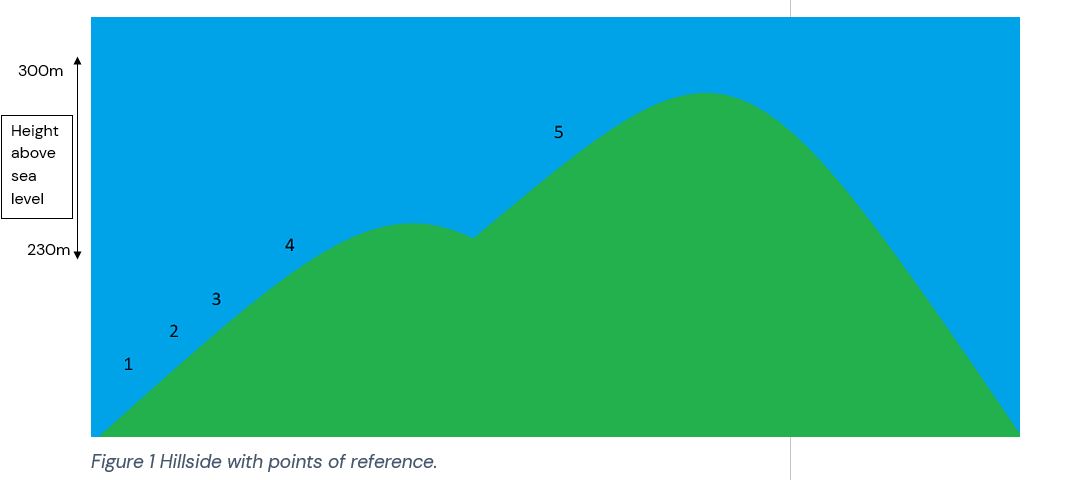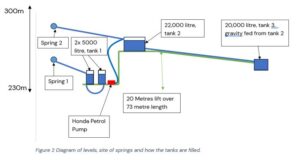Water Scarcity Case Study: Alternative watering of livestock
25 March 2024Background
Following an AECS application in 2016 to fence off watercourses from grazing livestock, combined with a move to outwintering of cattle, Whitriggs Farm had an increased demand on their water requirements. As extreme drought events are projected to increase, the business needed to take a new approach to how livestock were supplied with water in the fields.
Whitriggs farm extends to 442ha with 50 ha of cropping, 350 red deer and 140 suckler cows. Prior to 2016 most of the suckler cows drank from the burns, and having identified that poaching and contamination of water could be reduced by excluding livestock from these burns, this increased the requirement on the spring water taken from west side of Ruberslaw.
Water supply
In order to ensure a sufficient supply of water the business had to first identify the current water supply on the farm, where water was required, and then come up with a plan to install a new watering system. An ungrazed area of land with natural springs was chosen as the water supply to the farm. Therefore, with two springs, three new tanks, a pump and water pipe the new system was drawn up on paper and work began.

Figure 1 shows the different sites of infrastructure involved in the project against the hill backdrop. The height above sea level is shown on the left-hand side. The numbers on the figure show the locations of:
- Lowest tank (tank one, 10,000 litre capacity. Fed by the lowest spring).
- Spring one (dries up late September).
- Highest tank (tank two, 22,000 litre capacity. Fed from the highest spring).
- Spring two (dries up early July).
- Highest point of grazing cattle.

Figure 2 shows how the system has been designed in order to combat spring two drying up.
Spring two dries up in early July and until that point can fill tank two directly, which in turn then feeds tank three situated around 800 metres away. However, when spring two dries up all of the livestock rely solely on water from tank one, (fed by spring one) which sits at a point lower than where the cattle graze. In order to combat this a petrol water pump was purchased.
The image below shows spring one with a pipe dug into it which fills a small reservoir which then fills tank one. From this tank the petrol pump then fills tank two which sits 20 metres higher up 73 metres away. When this tank is full it can gravity feed tank three which supplies the rest of the farm.


Spring one which feeds tank one by gravity
Tank one (10,000 litre capacity)


Pump which moves 10,000 litres from tank one to tank two
Tank two (22,000 litre capacity). This supplies an additional tank (tank three 20,000 litre capacity 800 metres away)
Tank two then gravity fills tank three which is situated 800 metres away. The fall is less than the height of the tank, therefore tank two needs to be kept topped up to keep tank three full. Troughs can then be filled from the individual tanks or anywhere along the line between tanks two and three. This approach has ensured a clean source of water for livestock throughout the year at a low cost.
With all tanks kept full this gives a capacity of 52,000 litres. The estimated demand on water for 90 cows and calves was around 8,000 litres per day. For cows alone there is sufficient storage to last nearly one week.
In order to keep track of water levels and to avoid tanks running empty the farm has installed remote sensors on each tank (figure 3). These low-data, low-power-use sensors deliver water level information back to a base station at the farm which can then be viewed on a smart phone. This not only monitors water levels but also gives an indication of the time taken to fill the respective tanks, which can then inform of the rate of flow from each spring. This can allow a prediction of when the individual springs will dry up and when the system needs to move to a lower spring utilising the pump.

Figure 3 LoraWan receiver unit
Considerations
Things to consider when addressing water scarcity for livestock.
- Where are your livestock grazing?
- How does grazing location compare with water availability?
- Check OS maps for contours and land heights.
- When does water become scarce?
- Do you have any storage?
- Can tanks be installed to increase storage?
- Does grazing system impact the situation of troughs?
- Can water be diverted to a central storage location?
- If water needs to be pumped uphill is this practical?
With water scarcity expected to become more prevalent in future years, the relatively low-cost system that has been installed at Whitriggs will ensure grazing livestock have access to fresh clean water whilst having no impact on water quality on burns and streams that were previously grazed. It is a great example of a system which has its own challenges with topography, but some thought and planning has meant there is a reliable system in place fit to supply water year-round.
Related FAS Resources
Water management resources for farmers from Farm Advisory Service (fas.scot)
Sign up to the FAS newsletter
Receive updates on news, events and publications from Scotland’s Farm Advisory Service
